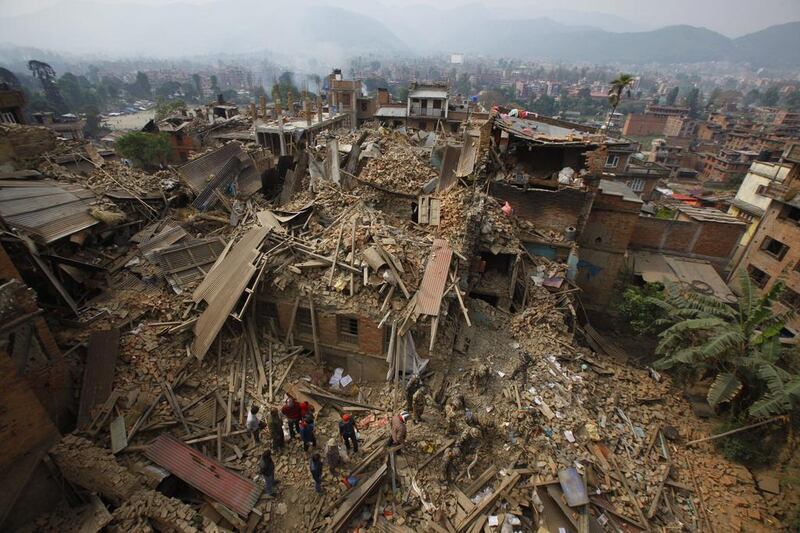KATHMANDU // Shell-shocked Nepalese cremated the dead and dug through rubble for the missing on Sunday amid aftershocks from the massive earthquake a day earlier.
The death toll passed 2,500 as planeloads of supplies, doctors and rescue workers from around the world began arriving in the country.
Many Nepalese in the capital Kathmandu have been living outdoors since Saturday’s magnitude 7.8 earthquake for fear of aftershocks. The worst of the tremors, with a magnitude of 6.7, hit early on Sunday afternoon, though no deaths or injuries were reported.
“The aftershocks keep coming ... so people don’t know what to expect,” said Sanjay Karki, the Nepal head for global aid agency Mercy Corps. “All the open spaces in Kathmandu are packed with people who are camping outdoors. When the aftershocks come you cannot imagine the fear. You can hear women and children crying.”
The earthquake destroyed swathes of the oldest neighborhoods of Kathmandu, and was strong enough to be felt all across parts of India, Bangladesh, Tibet and Pakistan.
Nepal authorities said at least 2,430 people died in that country alone, not including the 18 dead in an avalanche that struck the base camp used by climbers on Mount Everest. At least 18 people died there and 61 were injured, according to the Nepal Mountaineering Association.
Another 61 people died in India and a few in other neighbouring countries.
The death toll in Kathmandu was at least 1,152, and the number of injured nationwide was upward of 5,900. With search and rescue efforts yet to reach the remote region near the earthquake’s epicentre, the death toll is likely to rise.
The US Geological Survey said the quake was centered near Lamjung, about 80 kilometres north-west of Kathmandu, in the Gorkha district.
Roads to the area were blocked by landslides, hindering rescue teams, said chief district official Prakash Subedi. Teams were trekking through mountain trails to reach remote villages, and helicopters would also be deployed, he said by telephone.
Aid worker Matt Darvas from the group World Vision said he had heard that many remote mountain villages near the epicentre may have been completely buried by rock falls.
The villages “are literally perched on the sides of large mountain faces and are made from simple stone and rock construction”, Mr Darvas said.
“Many of these villages are only accessible by 4WD and then foot, with some villages hours and even entire days’ walks away from main roads at the best of times.”
Saturday’s earthquake was the worst to hit Nepal since a tremor measuring 8.0 in 1934 that all but destroyed the cities of Kathmandu, Bhaktapur and Patan.
Tens of thousands of Nepalese spent Saturday night outside under chilly skies, or in cars and public buses. They were jolted awake by strong aftershocks early on Sunday.
“There were at least three big quakes at night and early morning. How can we feel safe? This is never-ending and everyone is scared and worried,” said Kathmandu resident Sundar Sah. “I hardly got much sleep. I was waking up every few hours and glad that I was alive.”
Rescuers aided by international teams spent Sunday digging through rubble of buildings – concrete slabs, bricks, iron beams, wood – to look for survivors. Because the air was filled with chalky concrete dust, many people wore breathing masks or held shawls over their faces.
Hundreds of people in the western Kalanki neighborhood nervously watched the slow progress of a single backhoe digging into the rubble of the collapsed Lumbini Guest House, once a three-storey budget hotel frequented by Nepalese.
Police officer RP Dhamala, who was coordinating the rescue efforts, said they had already pulled out 12 people alive and six dead. He said rescuers were still searching for about 20 people believed to be trapped, but had heard no cries, taps or noises for a while.
Most areas were without power and water. The United Nations said hospitals in the Kathmandu Valley were overcrowded and running out of emergency supplies and space to store corpses.
Most shops in Kathmandu were closed after the government declared a weeklong period of recovery. Only fruit vendors and pharmacies seemed to be doing business.
“More people are coming now,” fruit seller Shyam Jaiswal said. “They cannot cook so they need to buy something they can eat raw.”
He said stocks were running out, and more shipments were not expected for at least a week, but added, “We are not raising prices. That would be illegal, immoral profit.”
With Kathmandu airport reopened, the first flights began delivering aid supplies. The first to respond were Nepal’s neighbours – India, China and Pakistan, all of which have been jockeying for influence over the landlocked nation.
Other countries sending support on Sunday included the United Arab Emirates, Germany and France.
After the chaos of Saturday – when little organised rescue and relief was seen – there was more order on Sunday as rescue teams fanned out across the city.
Workers were sending out tents and relief goods in trucks and helicopters and setting up shelters, said disaster management official Rameshwar Dangal.
Mukesh Kafle, the head of the Nepal Electricity Authority, said power was restored to main government offices, the airport and hospitals.
* Associated Press





